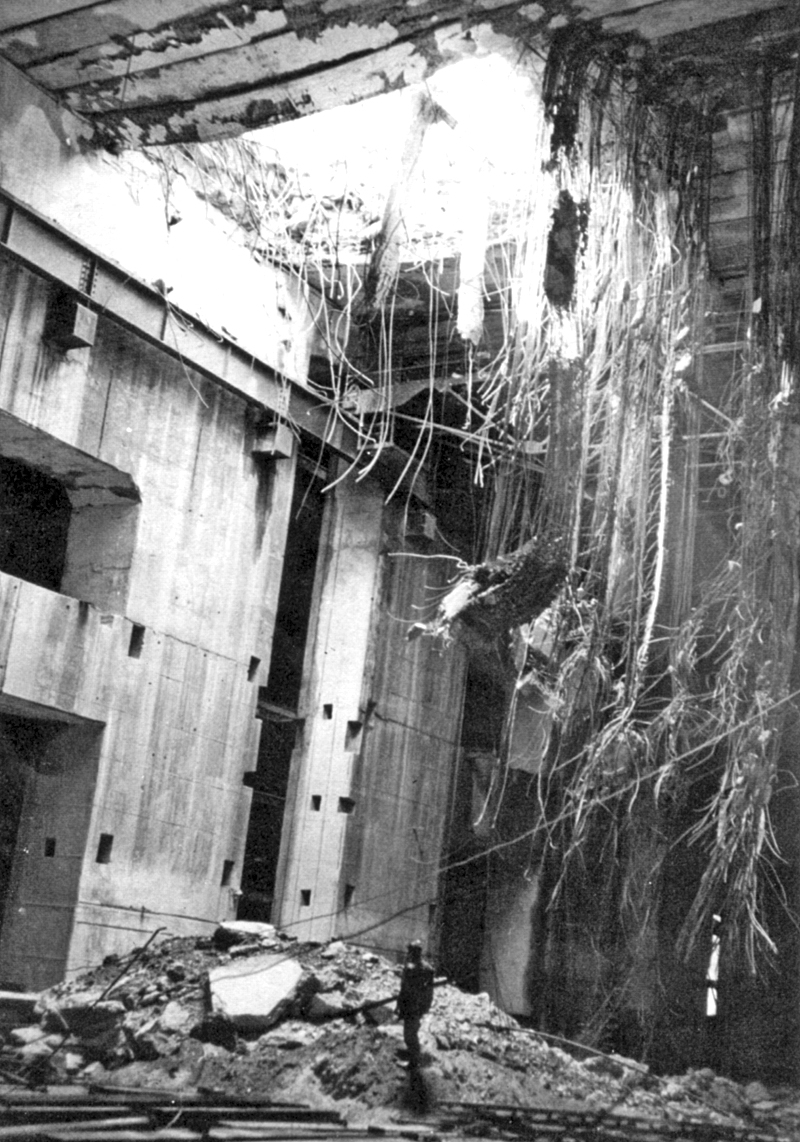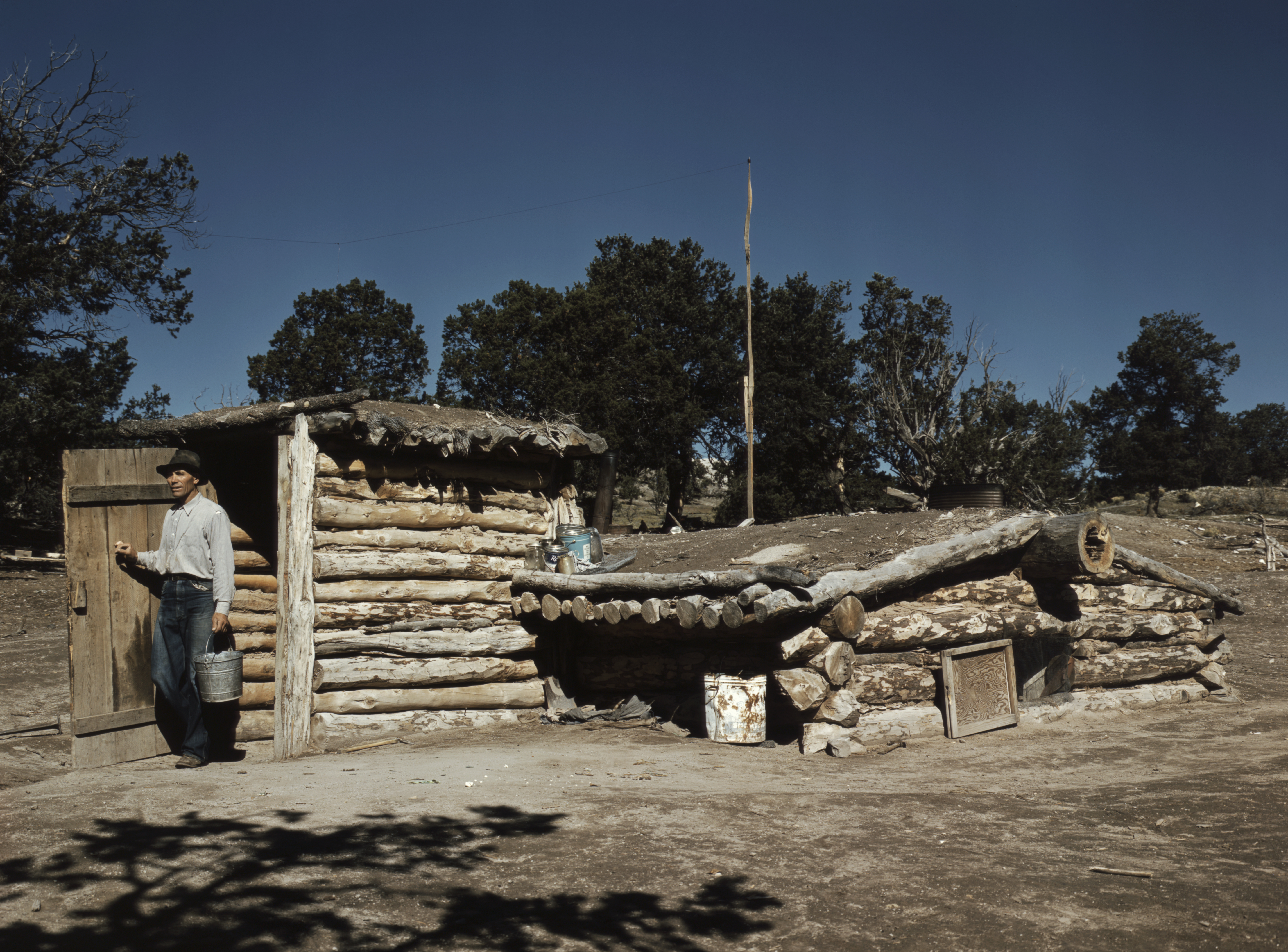|
Bunker
A bunker is a defensive military fortification designed to protect people and valued materials from falling bombs, artillery, or other attacks. Bunkers are almost always underground, in contrast to blockhouses which are mostly above ground. They were used extensively in World War I, World War II, and the Cold War for weapons facilities, command and control centers, and storage facilities. Bunkers can also be used as protection from tornadoes. Trench bunkers are small concrete structures, partly dug into the ground. Many artillery installations, especially for coastal artillery, have historically been protected by extensive bunker systems. Typical industrial bunkers include mining sites, food storage areas, dumps for materials, data storage, and sometimes living quarters. When a house is purpose-built with a bunker, the normal location is a reinforced below-ground bathroom with fiber-reinforced plastic shells. Bunkers deflect the blast wave from nearby explosions to prevent ear ... [...More Info...] [...Related Items...] OR: [Wikipedia] [Google] [Baidu] |
Führerbunker
The ''Führerbunker'' () was an air raid shelter located near the Reich Chancellery in Berlin, Germany. It was part of a subterranean bunker complex constructed in two phases in 1936 and 1944. It was the last of the Führer Headquarters (''Führerhauptquartiere'') used by Adolf Hitler during World War II. Hitler took up residence in the ''Führerbunker'' on 16 January 1945, and it became the centre of the Nazi regime until the last week of World War II in Europe. Hitler married Eva Braun there on 29 April 1945, less than 40 hours before they committed suicide. After the war, both the old and new Chancellery buildings were levelled by the Soviets. The underground complex remained largely undisturbed until 1988–89, despite some attempts at demolition. The excavated sections of the old bunker complex were mostly destroyed during reconstruction of that area of Berlin. The site remained unmarked until 2006, when a small plaque was installed with a schematic diagram. Some ... [...More Info...] [...Related Items...] OR: [Wikipedia] [Google] [Baidu] |
Hochbunker
Air raid shelters are structures for the protection of non-combatants as well as combatants against enemy attacks from the air. They are similar to bunkers in many regards, although they are not designed to defend against ground attack (but many have been used as defensive structures in such situations). During World War II, many types of structures were used as air raid shelters, such as cellars, Hochbunkers (in Germany), basements, and underpasses. Bombing raids during World War I led the UK to build 80 specially adapted London Underground stations as shelters. However, during World War II, the government initially ruled out using these as shelters. After Londoners flooded into underground stations during The Blitz, the government reversed its policy. The UK began building street communal shelters as air raid shelters in 1940. Anderson shelters, designed in 1938 and built to hold up to six people, were in common use in the UK. Indoor shelters known as Morrison shelters were in ... [...More Info...] [...Related Items...] OR: [Wikipedia] [Google] [Baidu] |
Bunker Buster
A bunker buster is a type of munition that is designed to penetrate hardened targets or targets buried deep underground, such as military bunkers. Armor piercing shells Germany Röchling shells were bunker-busting artillery shells, developed by the German engineer August Cönders, based on the theory of increasing sectional density to improve penetration. They were tested in 1942 and 1943 against the Belgian Fort d'Aubin-Neufchâteau. Aircraft delivered bombs World War II Germany In World War II the Luftwaffe developed a series of unguided rocket-propelled armor-piercing bombs for use against shipping and fortifications. United Kingdom In World War II, the British designer Barnes Wallis, already famous for inventing the bouncing bomb, designed two bombs that would become the conceptual predecessors of modern bunker busters: the five tonne Tallboy and the ten tonne Grand Slam. These were "Earthquake" bombs—a concept he had first proposed in 1939. The designs we ... [...More Info...] [...Related Items...] OR: [Wikipedia] [Google] [Baidu] |
Bunker (golf)
A hazard is an area of a golf course in the sport of golf which provides a difficult obstacle, which may be of two types: (1) water hazards such as lakes and rivers; and (2) man-made hazards such as bunkers. The governing body for the game of golf outside the US and Canada, The R&A, say that ''A "hazard" is any bunker or water hazard''. Special rules apply to play balls that fall in a hazard. For example, a player may not touch the ground with their club before playing a ball, not even for a practice swing. A ball in any hazard may be played as it lies without penalty. If it cannot be played from the hazard, the ball may be hit from another location, generally with a penalty of one stroke. The Rules of Golf govern exactly from where the ball may be played outside a hazard. Bunkers (or sand traps) are shallow pits filled with sand and generally incorporating a raised lip or barrier, from which the ball is more difficult to play than from grass. Bunker A bunker is a depression ... [...More Info...] [...Related Items...] OR: [Wikipedia] [Google] [Baidu] |
Coal Bunker
A coal bin, coal store or coal bunker is a storage container for coal awaiting use or transportation. This can be either in domestic, commercial or industrial premises, or on a ship or locomotive tender, or at a coal mine or processing plant. Domestic coal bunkers are associated with the use of coal in open fires or for solid-fuel central heating. Free-standing bunkers were commonly made of wood or concrete and are currently sold in materials including plastic or galvanised metal. Coal bins or bunkers could also form an outhouse or be partly or fully underground. Coal bins form or formed part of industrial plants, and were found on steam ship A steamship, often referred to as a steamer, is a type of steam-powered vessel, typically ocean-faring and seaworthy, that is propelled by one or more steam engines that typically move (turn) propellers or paddlewheels. The first steamships ...s. References {{architecture-stub Semi-subterranean structures Bin ... [...More Info...] [...Related Items...] OR: [Wikipedia] [Google] [Baidu] |
Blockhouse
A blockhouse is a small fortification, usually consisting of one or more rooms with loopholes, allowing its defenders to fire in various directions. It is usually an isolated fort in the form of a single building, serving as a defensive strong point against any enemy that does not possess siege equipment or, in modern times, artillery, air force and cruise missiles. A fortification intended to resist these weapons is more likely to qualify as a fortress or a redoubt, or in modern times, be an underground bunker. However, a blockhouse may also refer to a room within a larger fortification, usually a battery or redoubt. Etymology The term ''blockhouse'' is of uncertain origin, perhaps related to Middle Dutch ''blokhus'' and 18th-century French '' blocus'' (blockade). In ancient Greece Blockhouses existed in ancient Greece, for example the one near Mycenae. Early blockhouses in England Early blockhouses were designed solely to protect a particular area by the use of ar ... [...More Info...] [...Related Items...] OR: [Wikipedia] [Google] [Baidu] |
Augarten Flakturm Wien2008a
The Augarten is a public park of 52.2 hectares (129 acres) situated in the Leopoldstadt, the second district of Vienna, Austria. It contains the city's oldest Baroque park. In the north-west and north-east it borders (since 1900) on the 20th district, Brigittenau, in the north-east also on the former Nordwestbahnhof, from where the North Western Railway made its way to Bohemia, while to the south it faces the so-called '' Karmeliterviertel'' ("Carmelite quarter"), the historical Jewish quarter, followed by the Leopoldstadt. Until 1870 ( Vienna Danube regulation), the areas north and east of the Augarten were floodlands mostly uninhabited. The park is designed in the French Baroque style with elaborate flower gardens and impressive shady avenues of chestnut, lime, ash, and maple. Like most fenced public parks and gardens in Vienna it is open only in the daytime: the park's five gates close at sunset (signalled by a siren). The Augarten hosts a variety of facilities such as ... [...More Info...] [...Related Items...] OR: [Wikipedia] [Google] [Baidu] |
Coastal Artillery
Coastal artillery is the branch of the armed forces concerned with operating anti-ship artillery or fixed gun batteries in coastal fortifications. From the Middle Ages until World War II, coastal artillery and naval artillery in the form of cannons were highly important to military affairs and generally represented the areas of highest technology and capital cost among materiel. The advent of 20th-century technologies, especially military aviation, naval aviation, jet aircraft, and guided missiles, reduced the primacy of cannons, battleships, and coastal artillery. In countries where coastal artillery has not been disbanded, these forces have acquired amphibious capabilities. In littoral warfare, mobile coastal artillery armed with surface-to-surface missiles can still be used to deny the use of sea lanes. It was long held as a rule of thumb that one shore-based gun equaled three naval guns of the same caliber, due to the steadiness of the coastal gun which allo ... [...More Info...] [...Related Items...] OR: [Wikipedia] [Google] [Baidu] |
Dugout (military)
A dugout or dug-out, also known as a pit-house or earth lodge, is a shelter for humans or domesticated animals and livestock based on a hole or depression dug into the ground. Dugouts can be fully recessed into the earth, with a flat roof covered by ground, or dug into a hillside. They can also be semi-recessed, with a constructed wood or sod roof standing out. These structures are one of the most ancient types of human housing known to archaeologists, and the same methods have evolved into modern " earth shelter" technology. Dugouts may also be temporary shelters constructed as an aid to specific activities, e.g., concealment and protection during warfare or shelter while hunting. Africa Tunisia First driven underground by enemies who invaded their country, the Berbers of Matmata found underground homes the best defense against summer heat. Asia and the Pacific Australia Burra in South Australia's Mid-North region was the site of the famous 'Monster Mine' (copper) and ... [...More Info...] [...Related Items...] OR: [Wikipedia] [Google] [Baidu] |
Pillbox (military)
A pillbox is a type of blockhouse, or concrete dug-in guard-post, normally equipped with loopholes through which defenders can fire weapons. It is in effect a trench firing step, hardened to protect against small-arms fire and grenades, and raised to improve the field of fire. The modern concrete pillbox originated on the Western Front of World War I, in the German Army in 1916. Etymology The origin of the term is disputed. It has been widely assumed to be a jocular reference to the perceived similarity of the fortifications to the cylindrical and hexagonal boxes in which medical pills were once sold; also, the first German concrete pillboxes discovered by the Allies in Belgium were so small and light that they were easily tilted or turned upside down by the nearby explosion of even medium (240mm) shells. However, it seems more likely that it originally alluded to pillar boxes, with a comparison being drawn between the loophole on the pillbox and the letter-slot ... [...More Info...] [...Related Items...] OR: [Wikipedia] [Google] [Baidu] |
World War II
World War II or the Second World War, often abbreviated as WWII or WW2, was a world war that lasted from 1939 to 1945. It involved the World War II by country, vast majority of the world's countries—including all of the great powers—forming two opposing military alliances: the Allies of World War II, Allies and the Axis powers. World War II was a total war that directly involved more than 100 million Military personnel, personnel from more than 30 countries. The major participants in the war threw their entire economic, industrial, and scientific capabilities behind the war effort, blurring the distinction between civilian and military resources. Air warfare of World War II, Aircraft played a major role in the conflict, enabling the strategic bombing of population centres and deploying the Atomic bombings of Hiroshima and Nagasaki, only two nuclear weapons ever used in war. World War II was by far the List of wars by death toll, deadliest conflict in hu ... [...More Info...] [...Related Items...] OR: [Wikipedia] [Google] [Baidu] |
Second World War
World War II or the Second World War, often abbreviated as WWII or WW2, was a world war that lasted from 1939 to 1945. It involved the vast majority of the world's countries—including all of the great powers—forming two opposing military alliances: the Allies and the Axis powers. World War II was a total war that directly involved more than 100 million personnel from more than 30 countries. The major participants in the war threw their entire economic, industrial, and scientific capabilities behind the war effort, blurring the distinction between civilian and military resources. Aircraft played a major role in the conflict, enabling the strategic bombing of population centres and deploying the only two nuclear weapons ever used in war. World War II was by far the deadliest conflict in human history; it resulted in 70 to 85 million fatalities, mostly among civilians. Tens of millions died due to genocides (including the Holocaust), starvat ... [...More Info...] [...Related Items...] OR: [Wikipedia] [Google] [Baidu] |





.jpg)



